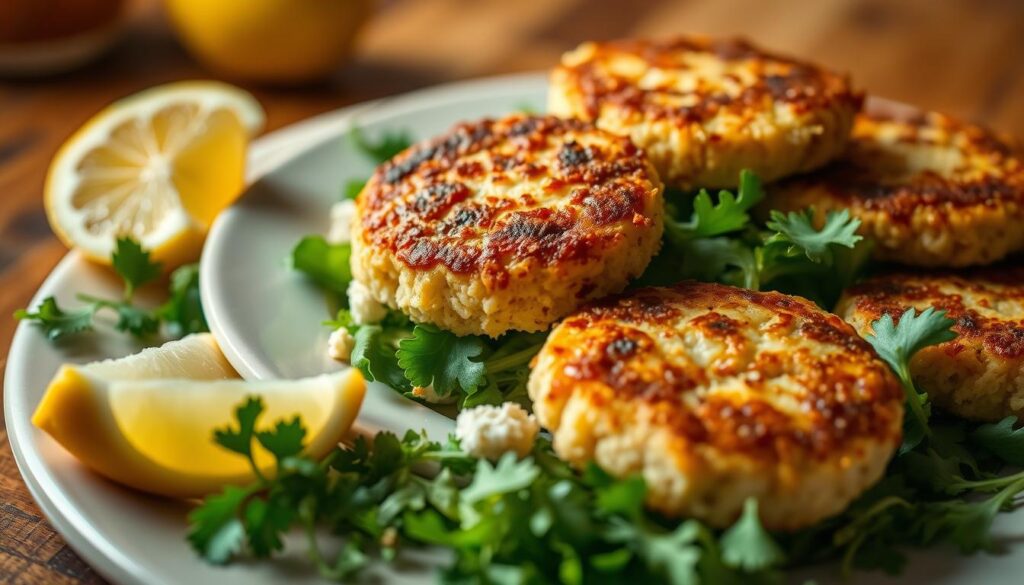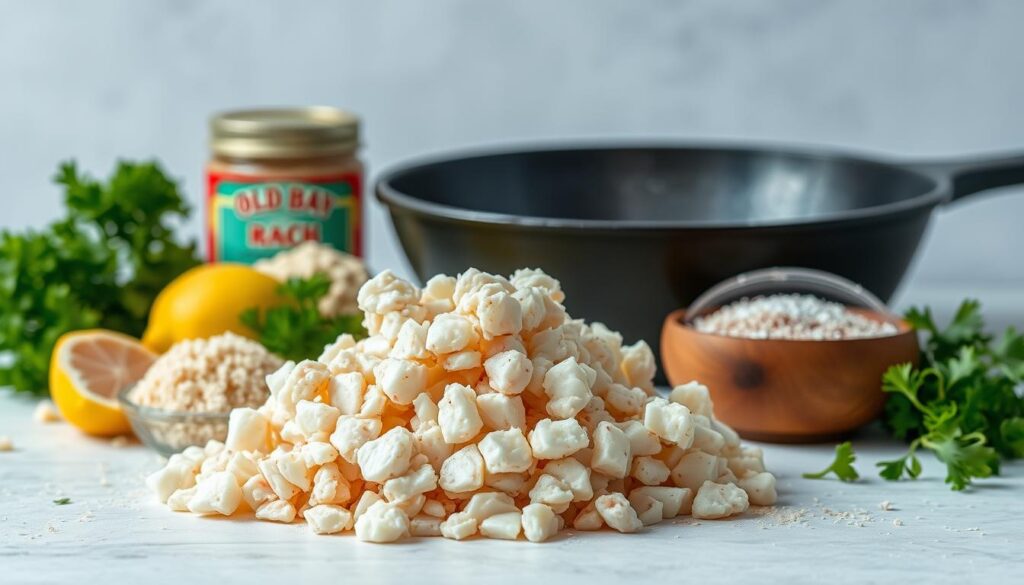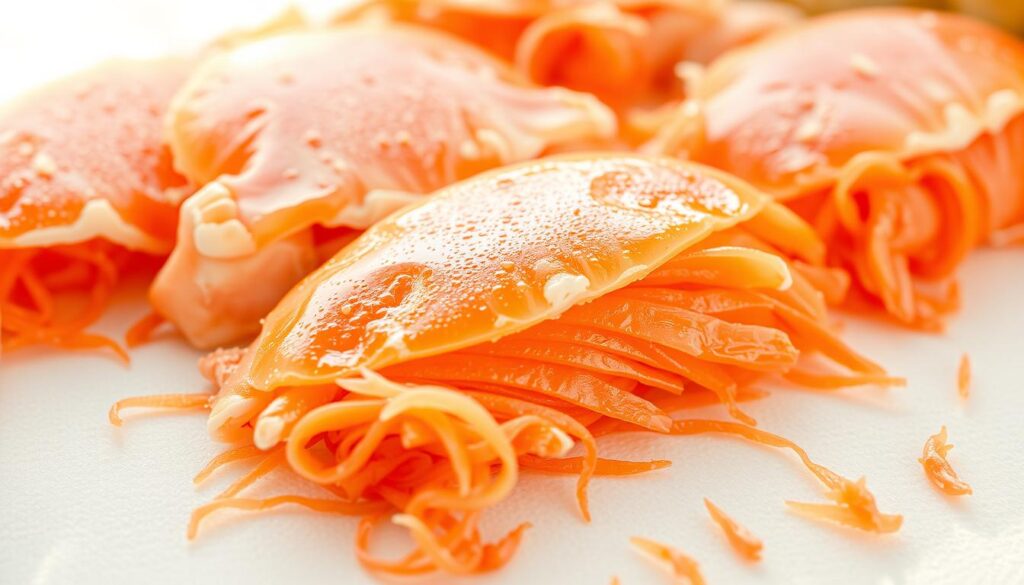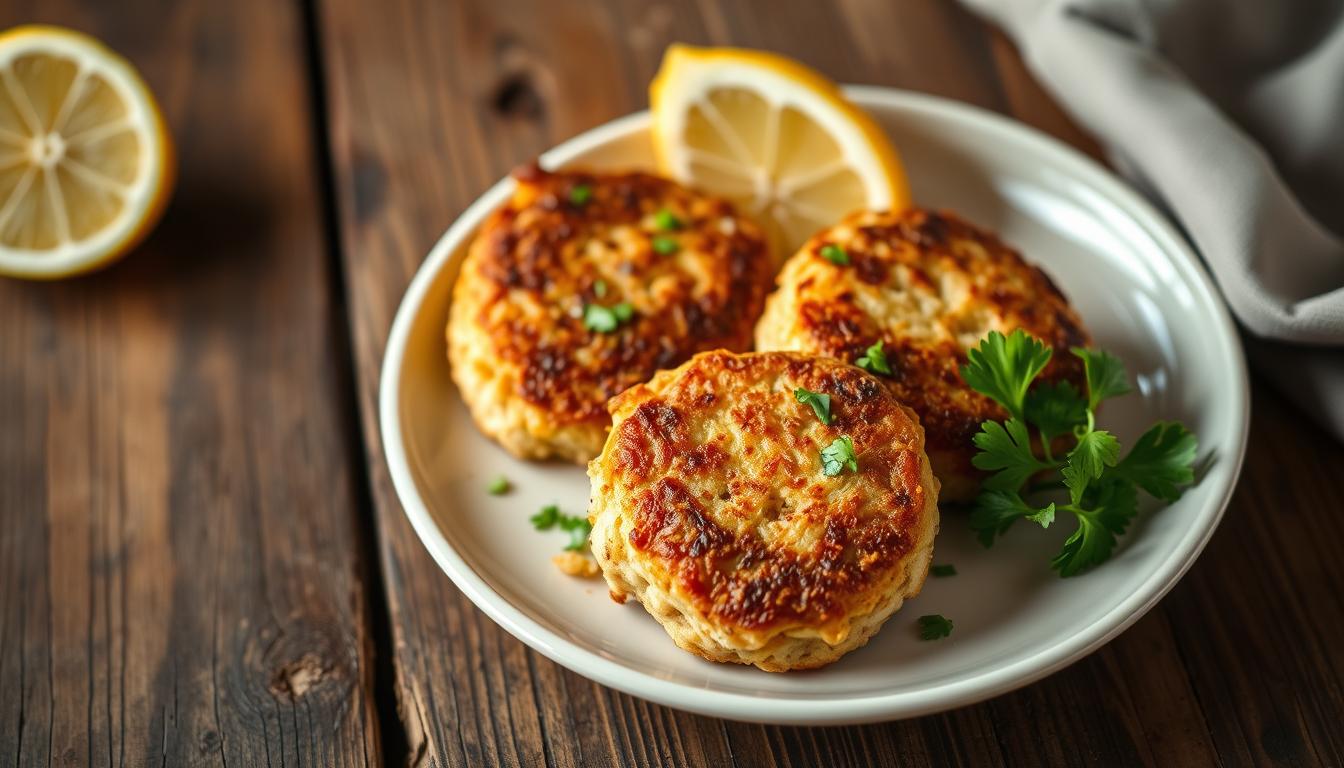Every summer, my family meets at the Chesapeake Bay. The smell of crab cakes fills the air. It sparked my love for making the perfect crab cake.
Making great crab cakes at home can be tough. It’s not just about mixing ingredients. You need to know the right techniques, use top-quality crab meat, and get the flavors just right.
In this guide, I’ll share four key fixes to make your crab cakes amazing. These tips work for both beginners and experienced cooks. They’ll make your crab cakes a hit with seafood fans.
Ready to improve your crab cake recipe? I’ll show you simple yet effective ways to enhance taste and texture. Your journey to making perfect crab cakes begins here!
Table of Contents
The Perfect Maryland-Style Crab Cake Recipe

Exploring Maryland crab cakes is diving into a tradition that values simplicity and fresh seafood. This dish is more than food; it’s a cultural experience. It showcases the delicate flavors of premium crab meat.
Maryland’s coastal cuisine has mastered the art of crab cakes. The best recipes use minimal ingredients. This lets the crab meat take center stage.
Understanding Traditional Maryland Flavors
Authentic Maryland crab cakes have a unique taste. They are known for:
- Fresh, high-quality lump crab meat
- Minimal bread crumb filler
- Signature Old Bay seasoning
- Light binding ingredients
Key Components of Authentic Taste
The secret to great Maryland crab cakes is in the ingredients. Look for:
- Selecting jumbo lump crab meat
- Using fresh herbs
- Balancing seasonings carefully
- Maintaining the natural texture of the crab
Regional Cooking Methods
Maryland’s cooking methods keep the crab meat’s flavor intact. People usually pan-fry or broil crab cakes. This makes the outside crispy and the inside tender.
“A true Maryland crab cake should taste like crab, not breading.” – Chesapeake Bay Cooking Tradition
Essential Ingredients for Superior Crab Cakes

Making a simple crab cake recipe begins with picking the right ingredients. The key to a great crab cake is its ingredients. They work together to give amazing flavor and texture.
Your crab cake recipe with Old Bay seasoning needs specific, high-quality ingredients. Let’s look at the essential parts that make a seafood dish special:
- Crab Meat: Always choose the freshest lump crab meat possible
- Eggs: Act as a crucial binding agent
- Mayonnaise: Provides moisture and richness
- Dijon mustard: Adds tangy depth
- Worcestershire sauce: Enhances umami flavor
- Old Bay seasoning: Delivers authentic Maryland-style taste
- Panko breadcrumbs: Creates a light, crispy exterior
When making your simple crab cake recipe, focus on the quality of your ingredients. Fresh herbs like parsley can make the taste better. A pinch of salt helps balance the flavors.
Pro tip: The secret to outstanding crab cakes is using minimal filler and letting the crab meat shine through.
Choosing the right breadcrumbs is key. Panko breadcrumbs are best because they make a delicate, crisp coating. This coating doesn’t overpower the crab meat.
Selecting the Best Crab Meat for Your Recipe

Choosing the right crab meat is key to making tasty crab cakes with bread crumbs. The quality of your seafood can turn a simple dish into a memorable one.
When making crab cakes with bread crumbs, it’s important to know the different types of crab meat. Not all crab meat is the same. Your choice can greatly affect the taste and look of your dish.
Jumbo Lump vs Regular Lump Crab
- Jumbo Lump Crab: Largest, most expensive pieces
- Regular Lump Crab: Smaller, more affordable option
- Ideal for maintaining cake structure and visual appeal
Fresh vs Canned Crab Meat Options
Fresh crab meat is best for your crab cake recipe with bread crumbs. Canned crab meat can’t match the taste and texture of fresh.
- Fresh Crab: Recommended for premium taste
- Canned Crab: Convenient but less flavorful
- Look for clear containers in refrigerated seafood sections
Quality Indicators to Look For
When picking crab meat, look for these quality signs:
- Clean, bright white or ivory color
- Minimal liquid in packaging
- Fresh, ocean-like smell
- Firm, intact meat pieces
Pro tip: Always buy crab meat from trusted seafood markets or reliable grocery stores with high turnover.
The Secret to Perfect Binding Ingredients
Making a tasty crab cake recipe is all about binding ingredients right. The right mix keeps your crab cakes together without covering up the seafood taste. Eggs and mayonnaise are key to getting the right texture in your crab cakes.
When picking binding ingredients, keep these tips in mind:
- Use fresh eggs as a main binder
- Go for high-quality mayonnaise for extra moisture
- Don’t add too much binder to keep the crab meat’s taste
Start with a small amount of binding ingredients. One egg and 2-3 tablespoons of mayonnaise are perfect for a pound of crab meat. Mix them gently to keep the crab pieces whole.
Pro tip: Always fold binding ingredients carefully to maintain the crab meat’s texture and integrity.
If you want other binding options, try these:
- Greek yogurt for a lighter binding
- Panko breadcrumbs to help hold the mixture
- Crushed crackers as a gluten-free option
The aim of your crab cake recipe is to boost, not hide, the fresh crab meat’s flavor. By mastering binding ingredients, you’ll make crab cakes that taste like they’re from a restaurant, right in your kitchen.
Mastering the Art of Seasoning Proportions
Seasoning is key to making crab cakes special. It’s what turns a simple dish into a feast for the senses. When making the best crab cakes, it’s important to balance flavors well.
Finding the right seasoning amount is crucial. Too little, and your crab cakes will taste bland. Too much, and the crab’s sweetness gets lost.
Old Bay Seasoning Guidelines
Here’s how to season your crab cakes perfectly:
- Use 1-2 teaspoons of Old Bay seasoning per pound of crab meat
- Adjust seasoning based on the type of crab meat you’re using
- Taste test your mixture before forming cakes
Balancing Herbs and Spices
Consider these herbs and spices for your crab cakes:
- Parsley – adds freshness
- Chives – provides a mild onion flavor
- Mustard powder – enhances depth
“Seasoning is an art, not just a science. Trust your taste buds!” – Professional Chef
The aim is to boost, not hide, the crab’s flavor. With time, you’ll get the seasoning just right for your crab cakes.
Step-by-Step Mixing and Forming Technique
Making the perfect crab cake recipe needs careful mixing and forming. Your method can greatly affect the final taste and texture of your crab cakes.
Begin by getting your ingredients ready. Handle the crab meat gently to keep those big lumps. This is key for the right texture.
- Use a large mixing bowl for ample space
- Measure ingredients precisely
- Avoid over-mixing the crab meat
When mixing, use a folding motion. This keeps the crab meat intact while spreading out the seasonings evenly.
- Place crab meat in the bowl first
- Add binding ingredients gradually
- Use a light folding motion with a spatula
- Stop mixing when ingredients are just combined
To shape the crab cakes, use about 1/2 cup of mixture per cake. Shape them into even patties, but not too tight. This ensures they cook evenly and stay tender inside.
Pro tip: Chill the formed crab cakes for 30 minutes before cooking to help them hold their shape.
Your simple crab cake recipe is now ready to become a tasty meal that looks great too!
Proper Chilling Time and Temperature Control
Making the perfect crab cake recipe is more than just mixing ingredients. It’s all about temperature control. This ensures your crab cakes are not only delicious but also hold their shape well during cooking.
Chilling is a key step in making the best crab cakes. Many home cooks miss this important step. It helps the ingredients bind together, so your crab cakes don’t fall apart when cooked.
Refrigeration Guidelines for Optimal Results
Here are the essential steps to keep your crab cakes in top shape and flavor:
- Chill formed crab cakes for at least 1 hour before cooking
- Use a covered container or plastic wrap to prevent moisture loss
- Keep refrigerator temperature between 35-40°F (2-4°C)
Storage Best Practices
Proper storage is crucial for keeping your crab cake recipe fresh. Here are some expert tips:
- Store uncooked crab cakes in the coldest part of your refrigerator
- Consume within 1-2 days for maximum freshness
- Use airtight containers to prevent contamination
“Chilling is not just about temperature—it’s about preserving the delicate texture of your crab cakes.” – Coastal Cooking Expert
Mastering these temperature control techniques will take your crab cake recipe to the next level. You’ll ensure every bite is as tasty as the last.
Pan-Frying vs Baking Methods Compared
Choosing the right cooking method is key for your crab cake recipe. Both pan-frying and baking have their own benefits for making the best crab cakes.
Pan-frying gives a golden, crispy outside that many love. The direct heat makes a nice crunch while keeping the crab meat tender. Use a good oil with a neutral taste to bring out the crab’s flavor.
Baking is a healthier option for crab cakes. It uses less oil and can still taste great. Here are some tips for baking crab cakes:
- Preheat the oven to 400°F
- Use a lightly greased baking sheet
- Chill crab cakes before baking to help them hold together
- Bake for 10-12 minutes, flipping halfway through
Your choice depends on what you like and your diet. Pan-frying gives that classic restaurant-style crispiness. Baking is a lighter, healthier way to enjoy this seafood favorite.
Pro tip: Always make sure the crab cakes reach 145°F for food safety.
Creating the Ultimate Homemade Tartar Sauce
Your crab cakes recipe deserves a top-notch sauce. A homemade tartar sauce can make your crab cakes go from good to amazing.
To make a delicious tartar sauce, you need a few basic ingredients. Start with high-quality mayonnaise. It’s key for that creamy texture that goes well with crab cakes.
- Fresh mayonnaise
- Sweet pickle relish
- Finely minced onion
- Fresh lemon juice
- Pinch of salt and pepper
Creating a great tartar sauce is all about balancing flavors. Experiment with the ratios until you get it just right. Some people add Dijon mustard or chopped capers for extra taste.
Pro tip: Always use fresh ingredients and let your sauce chill for 30 minutes before serving. This lets the flavors mix well.
Making your tartar sauce is easy. Just mix all the ingredients in a bowl, whisk well, and chill. This sauce is not just for crab cakes. It can be stored in the fridge for up to a week, making meal prep simpler.
Professional Plating and Serving Suggestions
Turning your homemade crab cake recipe into a dish fit for a restaurant is all about how it looks and tastes. The best Maryland crab cakes recipe is not just about flavor. It’s about creating a feast for the eyes and taste buds.
To make your crab cakes look great, pay attention to the little things. You want to show off their soft texture and golden color.
Elegant Garnish Options
- Fresh lemon wedges for a bright, citrusy accent
- Finely chopped parsley for a pop of green color
- Microgreens for a sophisticated touch
- Thin cucumber ribbons for added freshness
Complementary Side Dishes
Choosing the right sides can make your crab cakes even better. Here are some classic options that go well with Maryland-style crab cakes:
- Classic Coleslaw – crisp and tangy
- Grilled corn on the cob
- Roasted seasonal vegetables
- Light mixed green salad
By using these plating tips, you’ll make your crab cakes a special meal. It will be as good as the best Maryland crab cakes recipe.
Storage and Reheating Guidelines
Keeping your homemade crab cakes fresh is key. They need the right storage and reheating to stay tasty. Your crab cakes should always taste amazing.
Here’s how to store leftover crab cakes:
- Refrigerate crab cakes within 2 hours of cooking
- Store in an airtight container
- Keep refrigerated for up to 3-4 days
Freezing is also a great way to keep them longer. Wrap each crab cake in plastic wrap, then in a freezer-safe container. They can stay good for up to 3 months.
Reheating crab cakes needs care to keep them crispy and moist. Here are the best ways:
- Skillet Method: Warm over medium heat with a touch of oil
- Oven Technique: Bake at 325°F for 10-12 minutes
- Air Fryer: Heat at 350°F for 3-4 minutes
Pro tip: Avoid microwaving, as it can make your crab cakes soggy and compromise their delicate texture.
Always check the internal temperature reaches 165°F to ensure food safety when reheating your crab cake recipe. By following these storage and reheating guidelines, you’ll enjoy restaurant-quality crab cakes every time.
Conclusion
Making the perfect crab cake recipe is like a work of art. It mixes fresh ingredients, careful techniques, and a love for seafood. Your path to the best crab cakes starts with knowing how to balance flavors and textures.
The secret to great crab cakes is using top-notch crab meat. You also need the right amount of binding ingredients and a light touch with seasonings. Whether you’re cooking at home or dreaming of being a chef, these tips will take your crab cakes from good to amazing.
Practice is key. Every time you make crab cakes, you’ll get better at finding the perfect mix of consistency, seasoning, and cooking. Feel free to try new things and make the recipe your own. With patience and focus, you’ll soon wow everyone with your crab cakes.
Your cooking journey doesn’t stop here. Keep trying new things, tasting, and improving your crab cake recipe. The best dishes come from passion, creativity, and a desire to learn and get better with each try.

